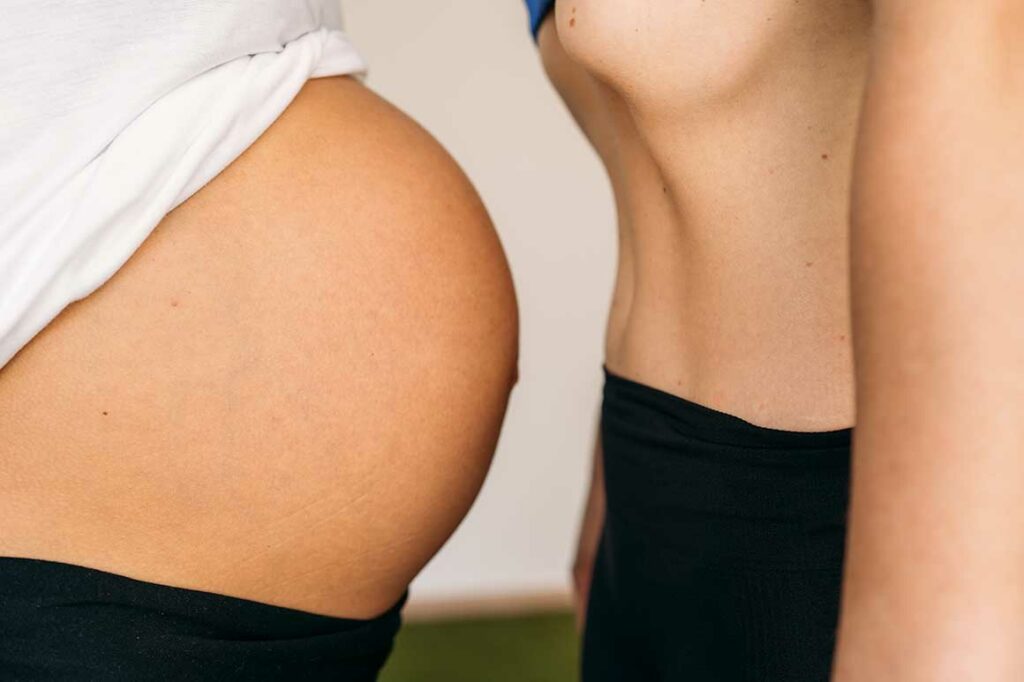
The CoreTone Fitness mission is to help you on your health journey by guiding you through our revolutionary program based on the latest Hypopressive training system.
Hypopressive training
This technique was created in the 1980’s by Marcel Caufriez, a Belgium doctor specialising in Women’s Health. It was initially developed for the treatment of pelvic floor dysfunctions and post-partum recovery, but soon became a preventive form of exercise for men as well as women. Throughout America and much of Europe the practice of Hypopressives is widespread today, with even athletes and bodybuilders using it as a training tool to prevent injuries and enhance specific training strategies.
The word ‘hypopressive’ is a combination of the prefix hypo-, which means low, and the word pressure. Thus ‘hypopressive’ means low-pressure, which describes the main characteristic of this technique – to reduce intra-abdominal pressure. This is achieved by doing a series of postural and breathing exercises in a planned sequence of poses that performed alternating diaphragmatic breathing with what we refer to as abdominal vacuums.
The abdominal vacuum is similar to an ancient yoga practice called Uddiyana Bhanda in which the breath is held after a deep exhalation and a controlled rib expansion is performed. During this action the diaphragm acts like a plunger, producing a vacuum effect on the abdominal area which pulls the abdomen in and the internal organs upwards. This anatomical response makes a useful tool in the treatment of pelvic organ prolapse symptoms.
Hypopressive training is a holistic approach to core and pelvic floor training as opposed to the traditional exercises that focus on one segment of the body at a time. The hypopressive training system is a combination of the following components:
- Postural training techniques that help realign the body
- Breathing techniques to improve the breathing patterns and core muscles synergy
- Myofascial stretching to normalise overall muscle and fascial tension
- Neurodynamic mobilisation to reduce neural tension and improve the function of the nervous system
- Neuroeducation to optimise the learning process of the hypopressive technique.
Considering all these aspects, we can see how hypopressive training can provide a wide range of benefits that not only can help in the treatment of pelvic floor and core dysfunctions, but alco can be incorporated in anyone’s training routine as a prevention tool and to improve overall health.

Hypopressive exercises are ideal if you:
- want to improve your core function and posture
- have given birth and need help to restore your pelvic floor
- suffer from back pain and need safe and effective exercise
- suffer from stress urinary incontinence or ongoing pelvic disorders
- are an athlete and want to enhance your performance
- want to integrate hypopressives into your professional practice.
For Women
Preparing Your Body For Pregnancy
If you are thinking about getting pregnant, start focusing on your health at least 3 months before you trying to get pregnant. Hypopressive training can help prepare your body to deal with the changes that you will go through during pregnancy and labour.

Improving your overall posture will help carry the baby with less discomfort. Good posture will contribute to a correct positioning of the baby in the belly which will help during labour. In addition, the diaphragmatic breathing as well as breath control learned with hypopressive training can be particularly useful during labour.
Also core synergy that will prepare for additional weight.
Hypopressive Training During Pregnancy
Is it safe to do Hypopressive exercises during pregnancy? Yes it is! BUT without performing the abdominal vacuums. Hypopressive training for pregnant woman is only based in the postural exercises and the diaphragmatic breathing. Although you may think that hypopressive exercises aren’t complete without doing the abdominal vacuum, this isn’t true. Maintaining good posture and correct breathing patterns are essential during pregnancy to help you carry a growing baby as well as setting the foundations of a correct core and pelvic floor synergy that will help in the post-partum recovery.
Is never too late to start hypopressive training! If you are already pregnant and have just discovered hypopressives, you can start with a basic routine of poses and breathing and progress into the practice once the baby is born.
The focus on reducing the intra-abdominal pressure during exercises makes hypopressives training a safe an efficient method to tone the core muscles after giving birth without compromising the pelvic floor function. The abdominal vacuum also helps in the recovery of abdominal diastasis and pelvic floor restoration.
Some conventional core and pelvic floor training programs may provoke a pathologically excessive tone of the pelvic floor and abdominal muscles leading to a constant state of abdominal hypertension. Which can cause many different problems and disorders, such as:
- Difficulty urinating, inability to empty the bladder fully, constant feeling of urgency and cystitis.
- Chronic pelvic and leg pain
- Difficulties during labour
- Excessive abdominal diastasis post birth.
Hypopressive techniques are designed to achieve the adequate resting tone of these muscles and the ability to manage the increases of intra-abdominal pressure when coughing, sneezing, running and any other activities without having to keep these muscles in constant contraction.
The hypopressive routine has many different poses designed to reduce overall pressure in the abdominal and pelvic cavities, in addition, the “plunger effect” produced by the diaphragm when performing the abdominal vacuum creates an uplifiting action that will help to maintain and reposition the internal organs in the pelvic cavity. It will also enhance blood circulation within the area improving tissue function and elasticity.
Unlike other pelvic floor training techniques, the Hypopressive technique stimulates the muscle fibres responsible for maintaining the tone of this muscle group. Although hypopressive training is not aimed to improve muscle strength, regular practice can help improve the ability to identify and properly contract the pelvic floor muscles and other muscles involved in stability and continence. By doing consistent Hypopressive exercises the pelvic floor muscles will maintain a normal resting tone and will be able to manage the internal pressures produced by actions such as coughing, sneezing or other more intense physical activities without suffering urinary leakage.
Rehabilitation
The combination of poses and moves involved in these exercises are based on the principle of spinal auto-elongation. This principle involves the stimulation of the muscle fibres responsible for the muscle tone, facilitating static posture. Additionally, these poses are designed to act upon the myofascial chains to normalise muscular and fascial tension and contribute to better posture and mobility.

The reduction of myofascial tension and improvement of the mobility and posture will have a positive impact in the treatment of back pain. The combination of the abdominal vacuum with the postural technique will also induce the activation of the tonic muscle fibres of the core and also will improve core muscle synergy which will improve stability and control.
Abdominal Separation (Abdominal Diastasis)
To date there is no consensus in the best protocol for abdominal diastasis treatment. The current approach is more focused in restoring the functionality of the abdominal wall and its capacity to provide support rather than just closing the distance between the abdominal bands. Aspect such as the quality of the connective tissue and the core muscles response to movement are highly involved in abdominal separation recovery.
Postural alignment plays an important role in reducing inter-recti distance by tensing the frontal muscular and fascial chain of the body. Good posture has the same effect of diastasis as when holding the bottom end of the zipper of your jacket to zip it up. Hypopressive training can help in the diastasis recti recovery by maintaining good static posture and restoring the ability of the core muscles to engage correctly during any movement.
When performing the Hypopressive specific breathing technique, the diaphragm (main muscle used for breathing) undergoes a maximum stretch, increasing its mobility and reducing the tension upon the intercostal muscles which are attached to the ribs and vertebrae.
Additionally, the specific poses included in the training routine are designed to involve other inspiratory muscles that assist in the rib cage expansion and achieve superior lung capacity. Various types of respiratory dysfunction such as asthma, can be improved with Hypopressive exercises. Good postural alignment will also assist correct breathing function by allowing the diaphragm as well as other respiratory muscles to move with less restrictions.
Sports Performance
When performing athletic type movements, weak, ineffective core muscle synergy places athletes at a higher risk of injury. When the internal pressures in the abdominal cavity are incorrectly managed, the weakest points of the core musculature are most affected.

This can result in herniation of the muscle walls both, abdominal and inguinal, cause the vertebral discs to bulge and/ or other mechanical compensations. These aspects will impact sports performance
Hypopressive exercises restore core muscle synergy involving not only the abdominal muscles but also the diaphragm, back and pelvic floor muscles. It will also help normalise overall muscle and connective tissue tensions, consequently minimising the risk of injuries whilst improving musculoskeletal function.
The practice of hypopressive exercises can induce diaphragm tone normalisation and enhance both inspiratory and expiratory muscle activity, resulting in greater lung capacity.
This has given rise to the following theories, which are currently being researched:
An increase oxygen supply to the muscles could result in an increase on VO2 max
Intermittent expiratory apneas involved in the hypopressive practice may also induce an increase in the production of endogenic erythropoietin (EPO) due to the intermittent hypoxia induced during the breath holding.
These two aspects make hypopressive training an exceptional tool to enhance endurance performance in runners, cyclists, triathletes, swimmers and even apnea divers.
Stress Induced Urinary Incontinence in Female Athletes
Stress urinary incontinence is a very common disorder among women athletes. It is defined as the loss of urine caused by a situation that increases intra-abdominal pressure, such as running, jumping or weight lifting. It’s highly prevalent amongst gymnast, weight lifters, runners and cross fitters.
The constant repetition of high impact activities can negatively affect the female pelvic floor, leading to severe perineal weakness, pathological lack of tone of pelvic floor muscles or even internal organ prolapse at an early age.
By including hypopressive exercises in athletic training programs for women, you will help to prevent these disorders, increasing the tone and functionality of the perineum, (which is anatomically different to men) and help to maintain a continent core i.e., a core that is capable of managing the intra-abdominal pressures produced by high impact movements included in athletic performance.
Pudendal neuralgia or pudendal nerve entrapment syndrome (also known as Alcock syndrome) is a chronic pelvic pain condition related to the pudendal nerve. The pudendal nerve is the main nerve of the perineum and it sends sensations from your genitals and anus to your brain. The pudendal nerve is also responsible for the control of your sphincter muscles, so its proper functioning is very important to maintain the tone of the pelvic floor muscles.
Muscle tension around this nerve can cause pain, numbness and dysfunction in the genitalia and rectum. Sitting for prolonged periods of time on a bicycle or practising sports that involve repetitive hip flexion can provoke impingement of this nerve, which can cause hypertonicity of the pelvic floor muscles. Hypopressives can be helpful in this case by normalising the pelvic floor tension hand helping relax these muscles.
Aesthetics
If you are looking for a method that effectively helps to flatten the stomach without resorting to boring, difficult and unsafe sit-ups the Core Tone is the solution.
The movement inwards and upwards of the abdominal wall produced by the diaphragm, provokes not only an eccentric contraction of the deep core muscles but also a reflex activation of the tonic fibres of the core muscles responsible for maintaining the resting tone necessary for body support and healthy posture.
Hypopressive training can be also incorporated in bodybuilding training programs as a way to exercise the deep core and postural muscles, not only to prevent abdominal distension caused by excessive hypertrophy of the abdominal and oblique muscles but also to achieve optimal joint mobility as well perfect alignment and body symmetry, so important in this discipline.